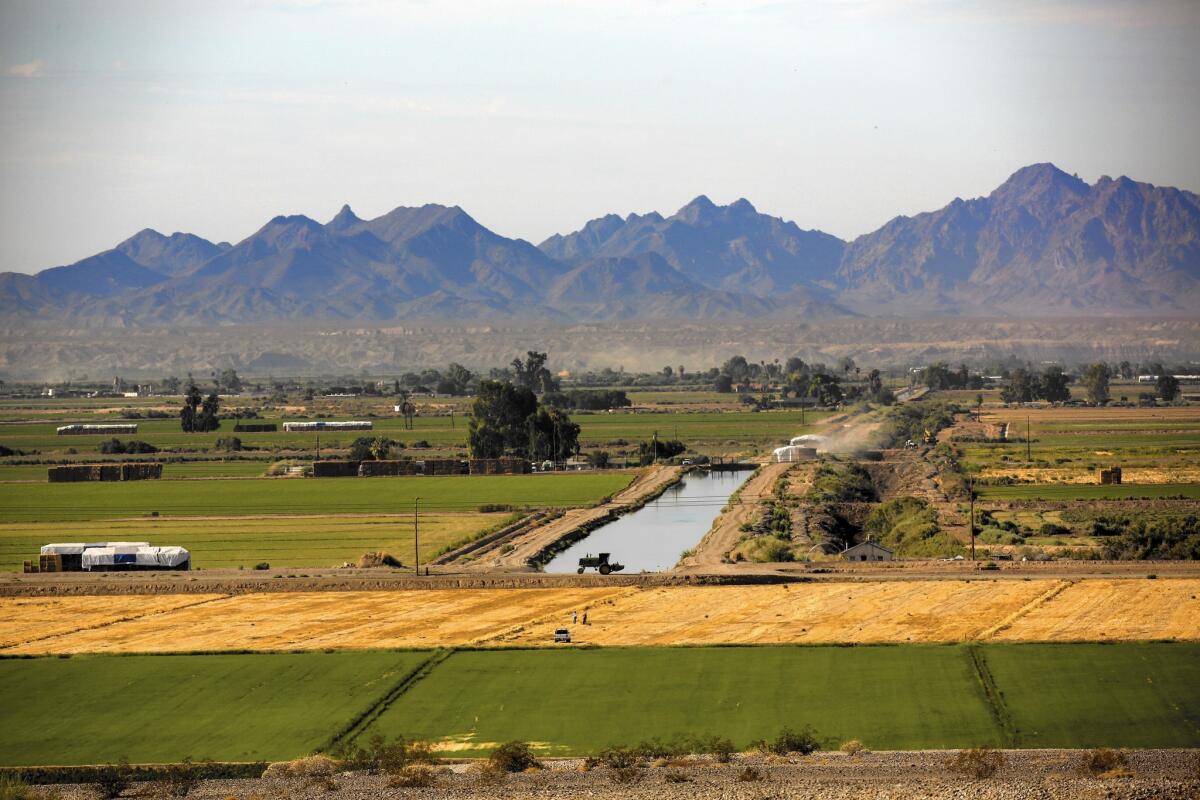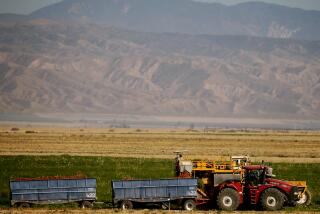Palo Verde Valley farmers and MWD find fallowing deal a win-win, so far

Reporting from Blythe â In the desert of California, where the Colorado River for decades has turned barren ground into an agricultural bounty, farmers are being paid not to grow crops on a portion of their land so that water can be shipped to thirsty cities on the coast.
In the Imperial Valley, so-called fallowing agreements have caused political upheaval, recriminations and litigation. The federal government had to threaten to take the water without compensation to get the Imperial Irrigation District to agree in 2003 to sell water to San Diego.
But just to the north, in the smaller Palo Verde Valley, a 35-year agreement signed in 2005 with the Metropolitan Water District of Southern California has enjoyed public acceptance by farmers and local officials. More than 90% of landowners signed up for the voluntary program.
Overshadowed by its larger neighbor, Palo Verde has become an increasingly important factor in Californiaâs struggle to overcome a four-year drought.
Next year the agreement between MWD and the Palo Verde Irrigation District will mean an additional 120,000 acre-feet of water for MWD to supply its customers in six counties â enough for 240,000 families. It may also allow MWD to leave water in Lake Mead, helping slow the lakeâs decline.
Despite some hard bargaining over money, Palo Verde has had virtually none of the contentiousness and sellerâs remorse that are a fact of life in the Imperial Valley.
Maybe Palo Verde has escaped much public notice because of its remoteness â Blythe, the irrigation districtâs headquarters, is 100 hard desert miles east of Indio, adjacent to the Colorado River on the edge of Riverside County.
#drylandsCA: A road trip during Californiaâs drought >>
But amid drought, the relationship between MWD and the Palo Verde Valley is changing.
Last month the mega-agency purchased 12,000 acres of farmland, which, combined with 8,000 acres it already owns, will make it the largest landowner in the valley.
Rumors swirled that MWD planned to fallow the entire 12,000 acres. When Los Angeles interests buy water rights, the specter of Owens Valley is close at hand.
To dispel the rumors, MWDâs general manager, board chairman and Colorado River resources manager plan to travel to Blythe to meet the Palo Verde Irrigation District board on Aug. 20 at a public meeting.
Their message: No harm will come to the agricultural economy of the Palo Verde Valley. MWD plans to abide by the 2005 agreement, which caps at 35% (26,000 acres) the amount of the valleyâs farmland being fallowed. More than 25,000 acres are fallowed currently.
NEWSLETTER: Get the dayâs top headlines from Times Editor Davan Maharaj >>
Randy Record, the MWD board chairman, said he wants to reassure farmers and others in Palo Verde that the local economy will not be hurt.
âIâm a farmer myself,â Record said. âFor me, the [fallowing] program is not a success unless it benefits both parties.â
Members of the Blythe City Council are set to attend the meeting in a show of support for the irrigation board and the water deal. In Imperial County, the Board of Supervisors went to court over the water sales.
Jack Seiler, a second-generation Palo Verde farmer and now president of the irrigation district board, said he believes the program has been good for farmers by providing an assured income not tied to the fluctuations of the market.
Seiler farms 3,600 acres and has been among those 70-plus farmers who have agreed to stop growing crops on a portion of their land. Landowners agreeing to be part of the program received an upfront payment, like a signing bonus.
A 2014 study commissioned by MWD concluded that the water sales deal has been a net economic positive for the Palo Verde Valley without an overall job loss. The program includes loans and grants to small businesses and in one particularly hot summer paid to keep the public swimming pool open.
::
The Palo Verde Valley is smaller than the Imperial Valley, and its farming community is more cohesive. âWe all went to high school together,â Seiler said.
In water, topography can be destiny, and the Palo Verde Valley, unlike the Imperial Valley, is blessed.
The Palo Verde Irrigation District takes about 900,000 acre-feet of water a year from the Colorado River. But about half of the water returns to the river after running off fields full of alfalfa and other crops.
The valleyâs farmland is adjacent to the river and has a north-to-south downward slope. Water pulled from the river can be fed by gravity to farms. Water that runs off the farmland can be returned to the river, also by gravity.
If the entire 900,000 acre-feet stayed in the ground, Palo Verdeâs large-scale use of water for such a small farming community (Blythe has a population of about 20,000) probably would have caught the attention of state and federal water officials â as it has in Imperial County, which is entitled to 3.1 million acre-feet a year and has a population of about 180,000.
In the Imperial Valley, the farmland is at a distance from the river and the land slopes south to north. Water from irrigated fields flows into the smelly, environmentally imperiled Salton Sea. The sea is shrinking, and Imperial officials have appealed to the state to avoid âenvironmental disaster.â
To make sure the irrigation runoff in Palo Verde returns to the Colorado River, the irrigation district has a system of channels and canals. The federal Bureau of Reclamation, which controls the river, measures the amount of the return flows and the degree of contaminants; so far, the bureau has been pleased.
âThis is what makes us unique to everybody,â said Ned Hyduke, general manager of the Palo Verde district, as he showed a visitor the Palo Verde Lagoon with a stream of green water flowing south to the Colorado River.
The system of returning water to the river for use by other agencies downstream, including the Imperial Irrigation District, is a matter of pride among Palo Verde farmers. âWe feel here we are the most progressive irrigation district on the river,â Seiler said.
Palo Verde has another distinction: the most senior rights of any California water agency that takes water from the Colorado River. San Francisco financier Thomas Blythe laid claim to the river in 1877, and on a plaque outside the Blythe library listing important events, his water-rights claim is at the top.
Each year, MWD decides how much water it wants to buy and thus how much land must be fallowed. Farmers are given a year to prepare to fallow.
Farmers receive a per-acre payment. MWD increases its allocation from the Colorado River by an amount equal to that used on the fallowed land in previous years.
Even in the current drought, state water officials have not cast their gaze on the Palo Verde Valley. If they ever do, the Palo Verde farmers say, they are ready â with lawyers if necessary.
With water, Seiler said, half the effort is getting the water to your fields, the other half is protecting your water rights.
On the wall of Hydukeâs office hangs a framed picture of John Wayne with a quote attributed to the actor from one of his western movies: âMy land, my water.â
Twitter: @LATsandiego
ALSO:
Californiaâs wealthy lagging in water conservation
Quiz: Test your knowledge of the California drought
The next drought: Water officials endorse a âless is moreâ strategy for the future
More to Read
Sign up for Essential California
The most important California stories and recommendations in your inbox every morning.
You may occasionally receive promotional content from the Los Angeles Times.










